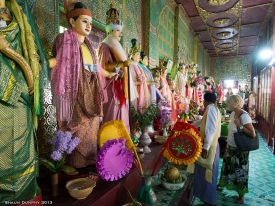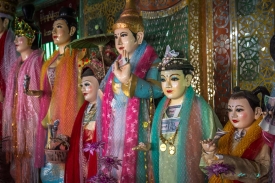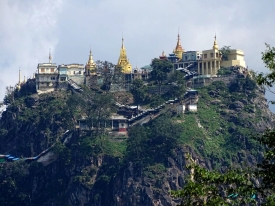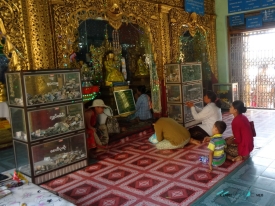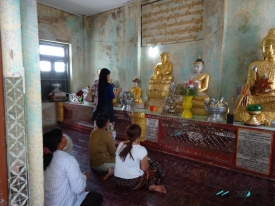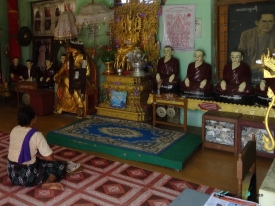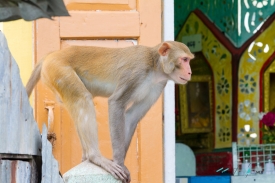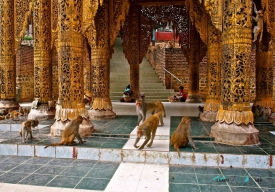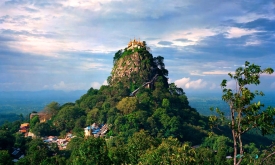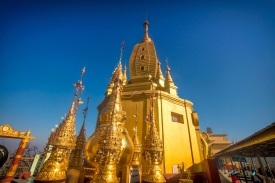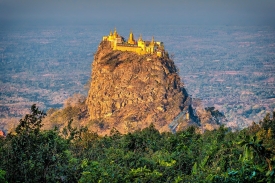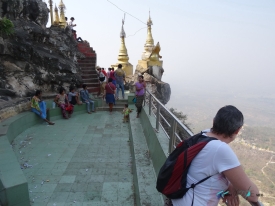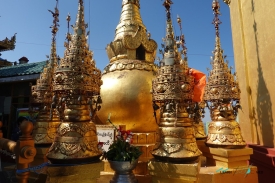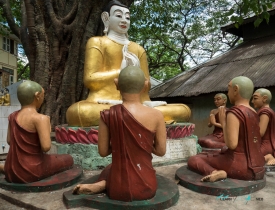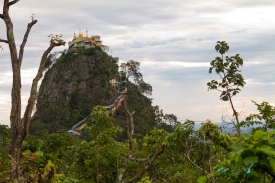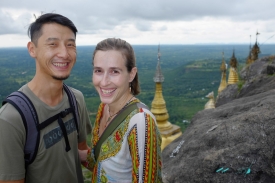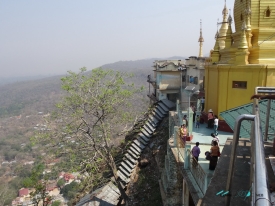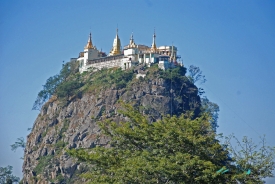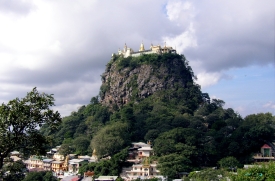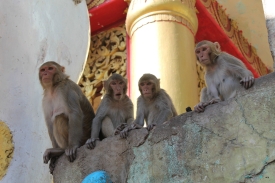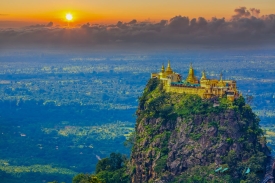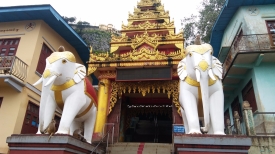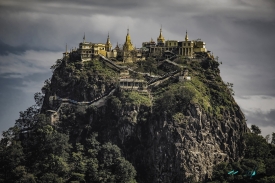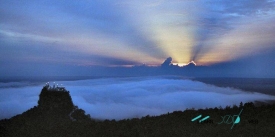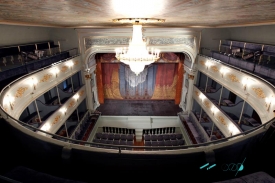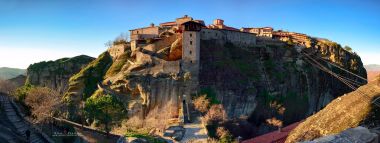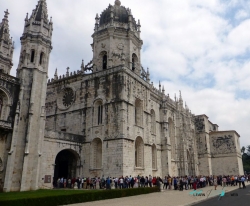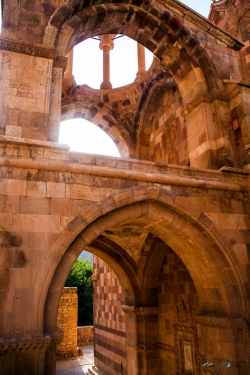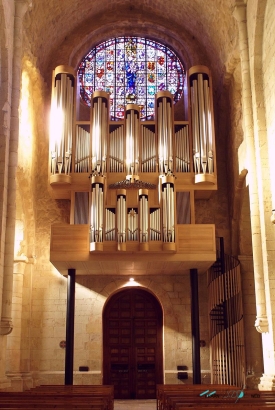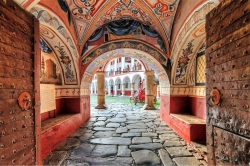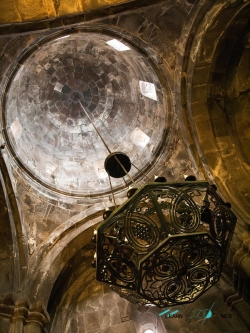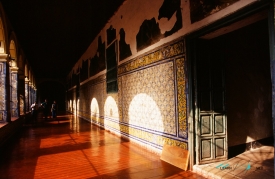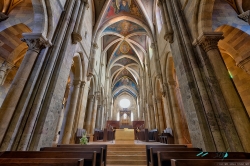ABOUT Popa Taung Kalat
Mount Popa's name is derived from the Sanskrit/Pali term Puppa meaning 'flower', while the term Taung Kalat means 'Pedestal Hill'. Taung Kalat, located on the top of Mount Popa, is a monastery made up of several Buddhist buildings, temples, dwellings, fountains, such as statues and relics that represent the Nats spirits.
Mount Popa is located in the Mandalay region, Nyaung-U district, south of Kyaukpadaung township. Mount Popa is 225 feet (737 meters) tall, and is actually a volcano. The crater is about 610 feet wide and 914 feet deep. and houses some of the rarest birds in the world, as well as medicinal plants inside. Mount Popa is known as the Mount Olympus of Burma. According to a legend, a Nat brother and sister from the Tagaung Kingdom, who were trying to escape from King Thinligyaung of Bagan, were given refuge on Mount Popa, where they were supposedly enshrined.
According to Burmese traditions, which have been passed down from generation to generation, the mount arose from the earth as a result of a great earthquake in the 5th century. The presence of Nat temples, predating the arrival of Buddhism, suggests the existence of a very old animist religious.
During the rule of the kingdom of Pagan, King Anawrahta would introduce Buddhism in the area, while maintaining the old animist traditions, consecrating the mount to Buddhism.
The monastery can be accessed by exactly 777 steps, and those who reach the top enjoy spectacular views in all directions. From the top of the mountain, you can see the distant temples of Bagan and the forested peak of Taung Ma-gyi.
Two very important festivals are celebrated during the full moon of Nayon, in the months of May and June, and also on the full moon of Nadaw, between November and December. Thousands of pilgrims arrive walking from the city of Kyaukpadaung to Mount Popa, between December and April, seeking to imbue themselves with the natural spiritual energy that emanates from Popa Taung Kalat.
The monkeys are the lords of Mount Popa, they have lived with humans for many centuries. They can be seen everywhere in the monastery, accompanying tourists and locals, always hoping to be rewarded with a bit of food. The tourist authorities recommend not socializing with the monkeys, keeping a safe distance from them, and especially not leaving anything within their reach that could attract their attention.
Can also find in the Mount Popa: barking deer, wild pig, jungle cat, wild dog and about 140 avifauna species inhabit the Popa area. The dusky leaf monkey is a scare animal and about 150 minkeys live in the Popa Mountain Park.
- From Yangon via Pyay and Kyaukpadaung to Popa, 412 miles by car.
- From Yangon via Meikhtila and Kyaukpadaung to Popa, 400 miles by car.
- From Yangon via Nyaung-U, 320 miles by air and 37 miles by car.
Mount Popa is located in the Mandalay region, Nyaung-U district, south of Kyaukpadaung township. Mount Popa is 225 feet (737 meters) tall, and is actually a volcano. The crater is about 610 feet wide and 914 feet deep. and houses some of the rarest birds in the world, as well as medicinal plants inside. Mount Popa is known as the Mount Olympus of Burma. According to a legend, a Nat brother and sister from the Tagaung Kingdom, who were trying to escape from King Thinligyaung of Bagan, were given refuge on Mount Popa, where they were supposedly enshrined.
According to Burmese traditions, which have been passed down from generation to generation, the mount arose from the earth as a result of a great earthquake in the 5th century. The presence of Nat temples, predating the arrival of Buddhism, suggests the existence of a very old animist religious.
During the rule of the kingdom of Pagan, King Anawrahta would introduce Buddhism in the area, while maintaining the old animist traditions, consecrating the mount to Buddhism.
The monastery can be accessed by exactly 777 steps, and those who reach the top enjoy spectacular views in all directions. From the top of the mountain, you can see the distant temples of Bagan and the forested peak of Taung Ma-gyi.
Two very important festivals are celebrated during the full moon of Nayon, in the months of May and June, and also on the full moon of Nadaw, between November and December. Thousands of pilgrims arrive walking from the city of Kyaukpadaung to Mount Popa, between December and April, seeking to imbue themselves with the natural spiritual energy that emanates from Popa Taung Kalat.
The monkeys are the lords of Mount Popa, they have lived with humans for many centuries. They can be seen everywhere in the monastery, accompanying tourists and locals, always hoping to be rewarded with a bit of food. The tourist authorities recommend not socializing with the monkeys, keeping a safe distance from them, and especially not leaving anything within their reach that could attract their attention.
Can also find in the Mount Popa: barking deer, wild pig, jungle cat, wild dog and about 140 avifauna species inhabit the Popa area. The dusky leaf monkey is a scare animal and about 150 minkeys live in the Popa Mountain Park.
Access
- From Yangon via Pyay and Kyaukpadaung to Popa, 412 miles by car.
- From Yangon via Meikhtila and Kyaukpadaung to Popa, 400 miles by car.
- From Yangon via Nyaung-U, 320 miles by air and 37 miles by car.
The Best Pictures of Popa Taung Kalat
Videos of Popa Taung Kalat





![Popa Taung Kalat, Myanmar [Amazing Places 4K]](https://i1.ytimg.com/vi/opAPwEN6bIQ/mqdefault.jpg)



